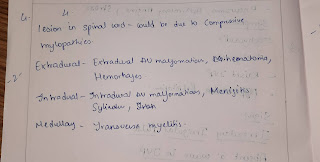Internal Assessment
Internal Assessment- Roll no: 6
Q1)define bone density, how it is measured?what are the causes ,clinical features ,diagnosis and management of osteoporosis?
https://rishik37.blogspot.com/2021/08/gm-elog-case-7.html
Bone mineral density: It is a measure of the mineral content of bone
Measured by: Dual energy X ray absorptiometry
Osteoporosis: Defined as a skeletal disorder characterized by compromised bone strength which predisposes and individual to an increased risk of fracture
Causes:
Q2)what is myxedema coma ?describe its clinical features, diagnosis and treatment of myxedema coma.
http://mahithguduri63.blogspot.com/2021/09/myxedema-coma.html(
Short notes
Q3) what is diagnostic approach of young onset hypertension and it’s treatment.
http://keerthykasa80.blogspot.com/2021/09/a-35-year-old-female-with-hypertensive.html(22nd
Q4) how do you clinically localise the anatomical level of lesion in spinal cord diseases.
http://sowmya9.blogspot.com/2021/08/21-year-old-with.html(2nd
Q5) causes, diagnosis, treatment of atrial fibrillation
Atrial fibrillation is an arrhythmia characterized by disorganized atria and produces multiple atrial foci fire impulses at a rate of 350-600/minute
Causes:
1. Cardiac causes- hypertensive heart disease, valvular heart disease, ischemic heart disease, heart failure
2.Non cardiac causes- Pneumonia, COPD, pulmonary Embolism, thyrotoxicosis, drugs and alcohol
Symptoms: palpitations, fatigue, syncope, angina and symptoms of cardiac failure and thromboembolism
Cardinal signs:
1. Irregularly irregular Pulse
2.Absence of a waves on IVP
3.Hypotension
4. Varying intensity of 1st heart sound, disappearance of 4th heart sound
Q11)role of sucralfate in treatment of corrosive gastritis
https://aishwaryagannoji35.blogspot.com/2021/09/45-year-old-female-with-vomiting-since.html
Q12) mention renal manifestations of snake bite
https://achalram1512.blogspot.com/2021/08/admission-65-year-old-male-from.html(
Q13)causes of portal hypertension
Q14) clinical features of Down syndrome
Q15) post streptococcal glomerulonephritis complications
-Rapidly progressive glomerulonephritis, Pulmonary edema, Hypertensive encephalopathy, Renal failure.
Q16) causes of cervical myelopathy
Rheumatoid arthritis of the neck,Whiplash injury or other cervical spine trauma, spinal infections,Spinal tumors and cancers
































Comments
Post a Comment